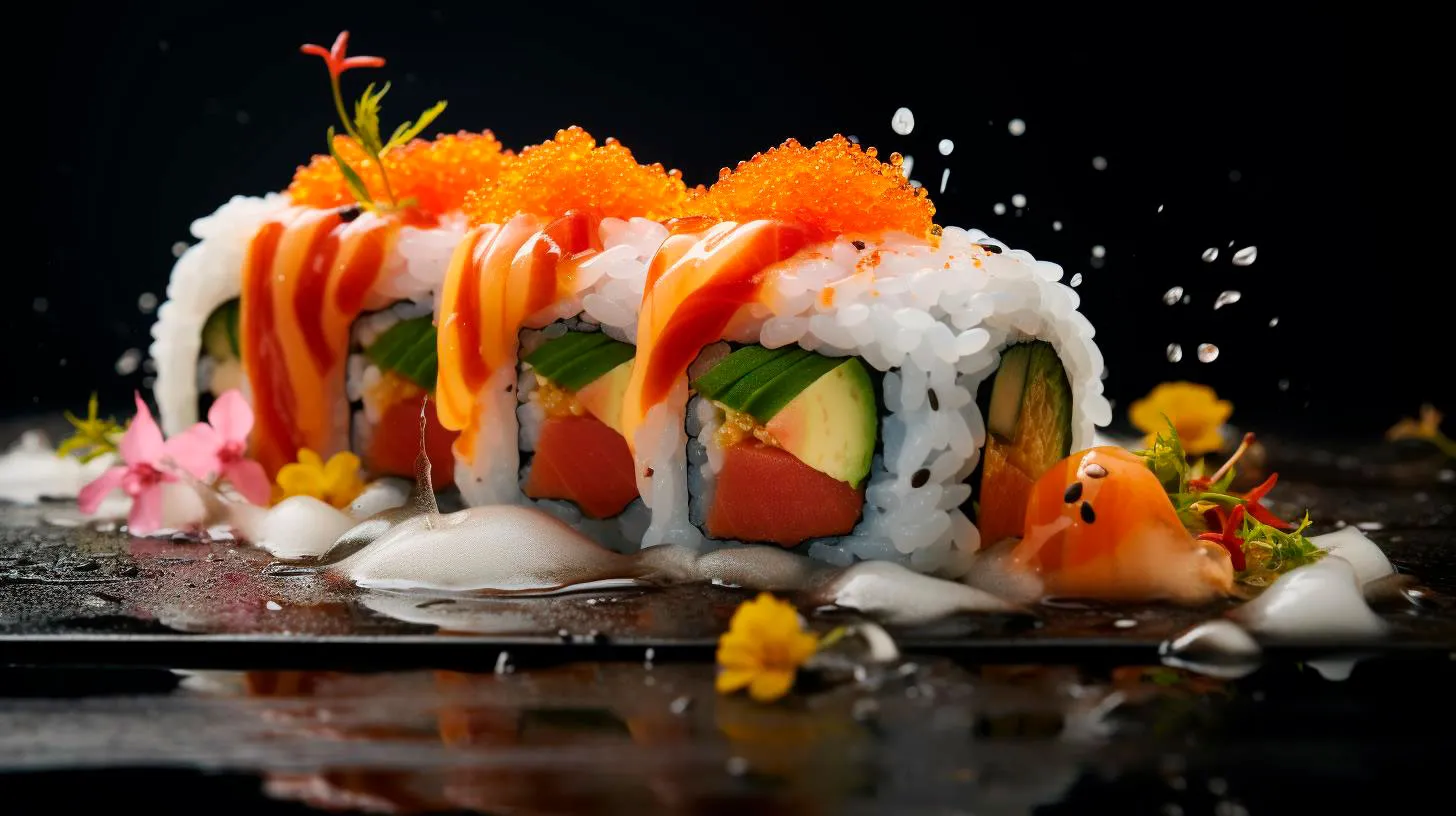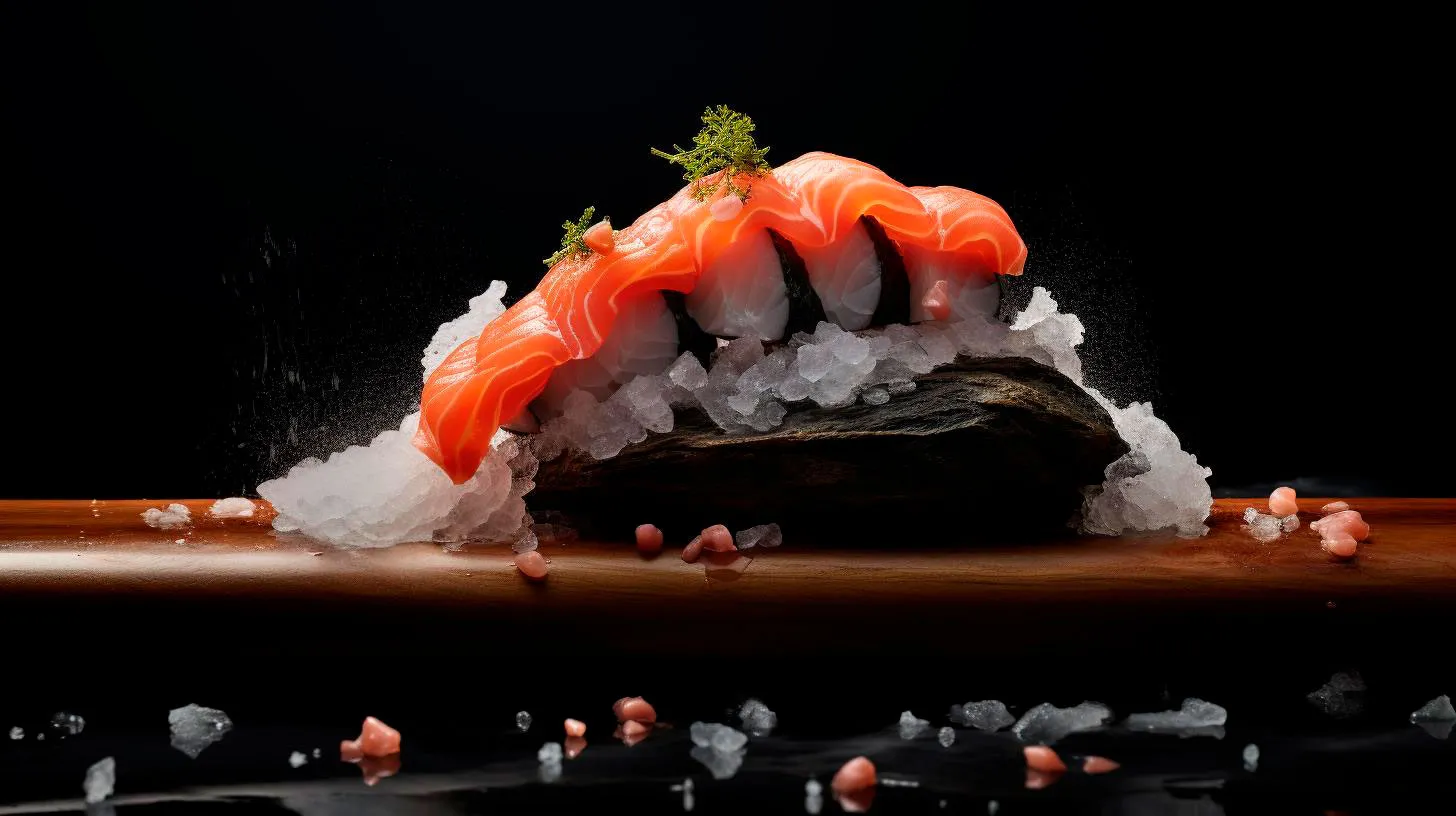Enhance Your Sushi Experience with Pickled Ginger and Wasabi
In this article, we will delve into the origins, uses, and benefits of pickled ginger and wasabi, as well as some tips on incorporating them into your sushi meals.
The Origins and Varieties of Pickled Ginger
Also known as gari, pickled ginger is a common side dish that adds a refreshing touch to sushi. The practice of pickling ginger can be traced back to ancient China, where it was used for its medicinal properties. Over time, this practice made its way to Japan and became an integral part of Japanese cuisine.
Pickled ginger is made by soaking young ginger roots in a mixture of vinegar, sugar, and salt. This combination not only gives it a distinctive sweet and tangy flavor but also enhances its vibrant pink color. The young ginger used for pickling is milder in taste and has a tender texture, making it a perfect complement to sushi.
There are different varieties of pickled ginger available, each with its own unique characteristics:
- Pink Pickled Ginger: The most common variety, it is characterized by its pale pink hue and mild flavor.
- Red Pickled Ginger: This variety is pickled using red shiso leaves, which give it a vibrant red color. It has a slightly stronger taste compared to the pink variety.
- White Pickled Ginger: Made without the addition of food coloring, this type of pickled ginger has a natural white color. It is less common but still offers a delightful flavor.
The Versatile & Bold Wasabi
Wasabi is another staple condiment in Japanese cuisine and is often referred to as Japanese horseradish due to its similar taste profile. Derived from the rhizome of the Wasabia japonica plant, true wasabi has a pungent and spicy flavor that packs a punch. However, it is worth noting that the majority of “wasabi” served in sushi restaurants is actually a mix of horseradish, mustard, and green food coloring.
Traditionally, wasabi is freshly grated into a paste right before consumption to preserve its intense flavor. It pairs exceptionally well with sushi as it offers a spicy kick that complements the rich flavors of various fish and seafood.
Key takeaways about Wasabi include:
- True wasabi has pungent and spicy flavors, elevating the taste of your sushi.
- Freshly grated wasabi paste enhances sushi by adding a spicy kick.
- Beware of imitation wasabi, which is often made from a mix of horseradish and mustard.
Health Benefits of Pickled Ginger and Wasabi
Both pickled ginger and wasabi offer more than just flavor; they also provide several health benefits. Here are a few reasons to incorporate these condiments into your sushi experience:
Pickled Ginger:
- May help aid digestion: Pickled ginger is commonly consumed between different types of sushi to cleanse the palate and prepare the taste buds for the next bite.
- Rich in antioxidants: Ginger is known for its high levels of antioxidants that help fight inflammation and protect against various diseases.
- Boosts the immune system: The combination of ginger and vinegar found in pickled ginger can help strengthen the immune system.
- May alleviate nausea: Ginger has long been used as a natural remedy to soothe an upset stomach or motion sickness.
Wasabi:
- Antibacterial properties: Wasabi contains compounds that have antibacterial properties, promoting oral health and reducing the risk of bacterial infections.
- Rich in phytochemicals: Wasabi is packed with phytochemicals that possess anti-inflammatory and antioxidant properties, contributing to overall wellbeing.
- Promotes cardiovascular health: Studies suggest that consuming wasabi may help reduce the risk of heart disease by preventing platelet aggregation and improving blood flow.
- Anticancer potential: Certain compounds found in wasabi have shown promising results in inhibiting the growth of cancer cells.
Remember, moderation is key when consuming pickled ginger and wasabi as they can be quite potent in flavor.
Tips for Enjoying Pickled Ginger and Wasabi with Sushi
To maximize your sushi experience, here are some tips on how to incorporate pickled ginger and wasabi:
- Use pickled ginger as a palate cleanser: Take small bites of pickled ginger between each piece of sushi to cleanse your palate and enhance the flavors.
- Enjoy wasabi in moderation: Start with a small amount of wasabi and mix it with soy sauce to create your desired level of spiciness.
- Experiment with different combinations: Try combining pickled ginger and wasabi in a single bite to experience their flavors in harmony.
- Try pickled ginger in other dishes: Pickled ginger can also be enjoyed as a condiment for other Asian dishes, salads, or even as a garnish for cocktails.
- Grate fresh wasabi if available: If you have access to real wasabi, consider grating it into a paste for an authentic and intense flavor.
By following these tips, you can truly elevate your sushi experience and enjoy the wonderful combination of flavors and health benefits that pickled ginger and wasabi bring to the table.
So, the next time you indulge in a plate of sushi, be sure to reach for the pickled ginger and wasabi to enhance your taste buds and nourish your body!
Pickled Ginger: A Must-Have Condiment for Sushi
From adding a burst of flavor to aiding digestion, pickled ginger enhances the overall sushi experience. In this article, we will delve into the key details and benefits of this must-have condiment.
What is Pickled Ginger?
Also known as Gari in Japanese, pickled ginger is made from young ginger roots. The ginger is thinly sliced or shredded and then pickled in a mixture of rice vinegar, sugar, and salt. This unique combination gives the ginger its distinct sweet and tangy taste. The pickling process not only infuses the ginger with flavor but also helps to preserve it, ensuring a longer shelf life.
Traditionally, pickled ginger is pale pink in color, but variations with a light yellow tint can also be found. The pink hue is achieved by adding a touch of beet juice during the pickling process. Apart from enhancing the visual appeal of a sushi platter, the pink color also symbolizes purity while the yellow tint represents the use of mature ginger roots.
Why is Pickled Ginger Served with Sushi?
Pickled ginger is not just a garnish; it serves a specific purpose in Japanese cuisine. There are several reasons why it is commonly served alongside sushi:
- Palate Cleanser: One of the primary reasons for serving pickled ginger with sushi is to cleanse the palate between different types of sushi. The tangy taste of the ginger helps to neutralize the flavors lingering in the mouth and prepares it for the next bite.
- Enhanced Flavor: Pickled ginger adds a burst of flavor to each bite. Its tangy and slightly spicy taste complements the delicate flavors of sushi, creating a perfect balance of sweet, salty, and sour.
- Antimicrobial Properties: Ginger is known for its antimicrobial properties, which can help kill bacteria and reduce the risk of foodborne illnesses. This makes pickled ginger a valuable addition to raw seafood dishes like sushi and sashimi.
- Digestive Aid: Ginger has long been used in traditional medicine for its digestive benefits. It is believed to stimulate digestion, alleviate nausea, and reduce bloating. Eating pickled ginger after a sushi meal can aid in digestion and provide relief from any potential discomfort.
Key Takeaways
With its tangy flavor and numerous benefits, pickled ginger is undeniably a must-have condiment for sushi lovers. To summarize the key features and advantages:
- Pickled ginger serves as a palate cleanser, preparing the taste buds for each bite of sushi.
- Its tangy taste enhances the overall flavor profile of sushi.
- The antimicrobial properties of ginger help reduce the risk of foodborne illnesses.
- It aids digestion and can provide relief from post-meal discomfort.
- Pickled ginger adds visual appeal to sushi platters with its vibrant pink or yellow color.
Industry Statistics:
Here are some interesting statistics related to sushi consumption and the popularity of pickled ginger:
- In 2019, the global sushi market was valued at over $22 billion and is projected to reach $26 billion by 2024.
- According to a survey, 93% of sushi eaters enjoy pickled ginger as a condiment with their sushi rolls.
- Research indicates that ginger consumption has increased by 26% in the past decade, driven by its health benefits and use in various cuisines.
In conclusion, pickled ginger is more than just a garnish; it adds depth, flavor, and health benefits to your sushi experience. So, the next time you indulge in a sushi feast, don’t forget to savor the tangy goodness of pickled ginger!
Discover the Unique Flavors of Pickled Ginger and Wasabi
Let’s take a closer look at the unique flavors and various uses of pickled ginger and wasabi.
Pickled Ginger: A Fiery Burst of Flavor
Known as “gari” in Japan, pickled ginger is widely used in Japanese cuisine, particularly in sushi. This vibrant condiment is made from young ginger roots that are thinly sliced and immersed in a mixture of vinegar, sugar, and salt. The resulting pickles are pale pink in color, with a distinctively spicy and tangy flavor.
Features and Advantages of Pickled Ginger:
- Refreshing and palate-cleansing: The zesty taste of pickled ginger refreshes your taste buds, preparing them for the next bite.
- Antimicrobial properties: Ginger possesses antimicrobial properties that may help combat certain bacteria and promote overall oral health.
- Stomach-soothing effects: Pickled ginger has long been used as a natural remedy for digestive problems like nausea and indigestion.
- Rich in antioxidants: Ginger is loaded with antioxidants that may help reduce inflammation and lower the risk of chronic diseases.
Whether you enjoy it with sushi, sashimi, or any other Japanese dish, pickled ginger is a must-try flavor that adds a unique twist to your culinary experience. Its vibrant color and tangy taste make it an appealing addition to any plate.
Wasabi: The Fiery Green Condiment
Wasabi, often referred to as “Japanese horseradish,” is a spicy condiment derived from the rhizome of the Wasabia japonica plant. The flavor of wasabi is sharp and pungent, with a distinctive spiciness that tickles your taste buds. It is commonly used as a dipping sauce for sushi and sashimi, but its uses go beyond that.
Features and Advantages of Wasabi:
- Aids digestion: Similar to pickled ginger, wasabi helps stimulate digestion and can relieve symptoms like bloating and gas.
- Antibacterial properties: Wasabi contains compounds that exhibit antibacterial activity, potentially helping to prevent food poisoning.
- Healthy heart support: Research suggests that consuming wasabi may have a positive impact on cardiovascular health due to its ability to lower blood pressure and promote healthy blood circulation.
- Rich in essential nutrients: Wasabi is a good source of vitamin C, dietary fiber, and various minerals, making it a nutritious addition to your diet.
Wasabi is not only a culinary delight but also offers valuable health benefits. Its vibrant green color adds a touch of elegance to your plate, while its fiery flavor adds a punch to any dish.
Key Takeaways
As we wrap up this journey into the world of pickled ginger and wasabi, here are the key takeaways:
- Pickled ginger, with its spicy and tangy flavor, is a popular accompaniment to sushi and offers refreshing and stomach-soothing benefits.
- Wasabi, known for its sharp and fiery taste, is a versatile condiment that aids digestion and provides antibacterial properties.
- Both pickled ginger and wasabi are rich in antioxidants and essential nutrients, contributing to overall well-being.
So, the next time you savor Japanese cuisine, embrace the unique flavors of pickled ginger and wasabi. Their enticing taste profiles and health benefits make them an essential duo in the realm of Japanese gastronomy.
Remember, whether you’re a food enthusiast or just someone looking to explore new tastes, pickled ginger and wasabi are sure to take your culinary experiences to a whole new level!
Wasabi: The Fiery Spice That Perfectly Complements Sushi
In this article, we will delve deeper into the world of wasabi, exploring its origin, benefits, and how it elevates the sushi dining experience.
The Origins of Wasabi
Wasabi, scientifically known as Wasabia japonica, is a plant native to Japan. Traditionally, it was grown in mountainous regions with cool temperatures and abundant water. Today, it is cultivated worldwide, but the best-quality wasabi still comes from Japan.
- The main growing regions for wasabi in Japan include Shizuoka, Nagano, Iwate, and Hokkaido.
- Wasabi is a member of the Brassicaceae family, which also includes mustard, cabbage, and horseradish.
The Benefits of Wasabi
Aside from its distinctive flavor, wasabi offers several health benefits:
- Antibacterial properties: Wasabi possesses antimicrobial properties that help combat harmful bacteria. This is particularly important when enjoying raw fish, as it reduces the risk of foodborne illnesses.
- Digestive aid: The compounds found in wasabi stimulate the production of enzymes in the pancreas, aiding digestion and enhancing nutrient absorption.
- Anti-inflammatory effects: Wasabi contains isothiocyanates that have anti-inflammatory properties, potentially providing relief from conditions such as arthritis and asthma.
- Rich in nutrients: Wasabi is a good source of vitamin C, dietary fiber, and minerals, including calcium, potassium, and magnesium.
Wasabi and Sushi: A Perfect Pair
When it comes to sushi, wasabi is an essential condiment. Here’s why:
- Flavor enhancement: The pungent flavor of wasabi complements the subtle taste of raw fish, adding complexity to each bite. It balances the richness of fatty tuna or salmon with its spicy kick.
- Food safety: Wasabi’s antibacterial properties help ensure the freshness and safety of the sushi. In traditional sushi bars, a small amount of wasabi is often placed between the fish and rice to prevent bacteria growth.
- Palate cleanser: The potent flavor of wasabi acts as a palate cleanser, preparing your taste buds for the next slice of sushi. It clears the palate, allowing you to savor the unique flavors of each variety.
It’s worth noting that there are two common forms of wasabi available: real wasabi and imitation wasabi. The real wasabi is made by grating the fresh root of the plant, while imitation wasabi is typically a blend of horseradish, mustard, and green dye.
Key Takeaways
Next time you indulge in sushi, don’t forget to appreciate the role of wasabi in elevating your dining experience:
- Wasabi adds complexity and depth to the flavors of sushi, balancing the richness of raw fish.
- Its antibacterial properties contribute to food safety, ensuring the sushi remains fresh.
- As a palate cleanser, wasabi prepares your taste buds for each new flavor.
So, the next time you savor a piece of sushi, take a moment to appreciate the fiery kick of wasabi and the artistic harmony it brings to your culinary journey.



